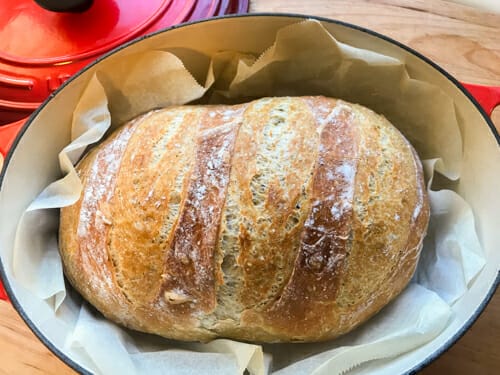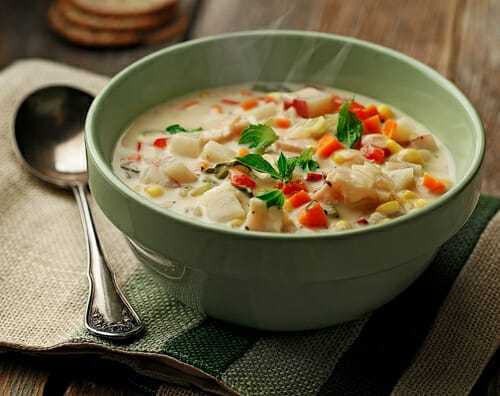Chicken Noodle Soup From Scratch
This classic chicken noodle soup is a classic comfort food. It’s perfect for soothing symptoms of colds and sore throats. And that’s not just hype, as this CNN article indicates, there is evidence to support the long time tradition of a hot bowl of chicken noodle soup. I think it’s especially good when made with homemade chicken stock.
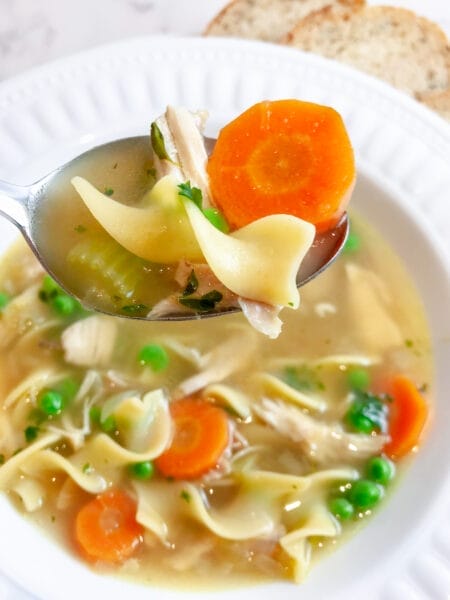
Also Read: Homemade Vegetable Soup Stock, What You Need to Know When Making Soup, How to Make Stock from Cooked Chicken, How to Make Ham Bone Stock
Why is Chicken Noodle Soup Healthy?
Is chicken noodle soup actually beneficial for fighting colds? What makes it healthy? There may not be a lot of conclusive scientific research that proves chicken noodle soup cures colds, but cultures throughout the world use some variation of chicken soup to comfort and nourish those that need a boost. There’s no denying that chicken soup can provide comfort and nourishment for people not feeling well. Here’s why chicken soup helps you feel better:
- Nutrient-rich broth: The broth in chicken noodle soup is typically made by simmering chicken bones, vegetables, and herbs, which creates a nutrient-rich base. This broth provides essential nutrients like vitamins, minerals, and amino acids. You have the greatest control over these nutrients when you make stock from scratch. Make it from leftover carcass or start with raw chicken.
- High Quality Protein: Chicken is a good source of lean protein, which is essential for muscle repair, immune function, and overall body maintenance.
- Nutrient Rich Vegetables: Chicken noodle soup usually contains a variety of vegetables, such as carrots, celery, and onions. These vegetables add vitamins, minerals, and antioxidants to the soup, contributing to its nutritional value.
- Immunity Boosting Herbs and Spices: The garlic, ginger and turmeric in this recipe not only add depth of flavor, but also add anti-inflammatory, antioxidant properties and anti-inflammatory benefits.
- Hydration: The liquid content of the soup helps keep you hydrated and soothes a sore throat. Staying well-hydrated is crucial for various bodily functions and is especially beneficial when you’re feeling under the weather.
- Easy to Digest: When you’re feeling unwell or have a reduced appetite, chicken noodle soup is often easy to digest. The warm broth can be soothing, and the combination of ingredients provides a balanced and comforting meal.
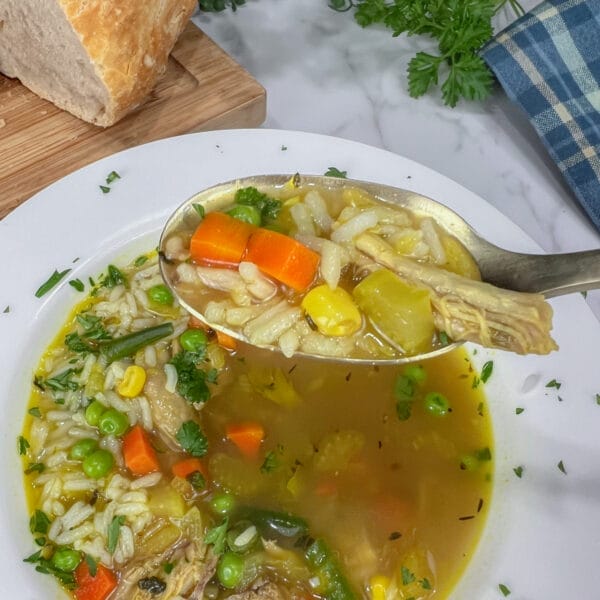
Key Ingredients in Chicken Noodle Soup
Chicken noodle soup relies on simple, quality ingredients to deliver on it’s promise to nourish and heal the body. Get the best ingredients you can. Here’s the key ingredients for maximum nourishment and to help fight colds.
- Chicken:
- Chicken is a vital component for a nourishing soup, especially when someone is not feeling well. It provides a high-quality protein source that supports the body in recovering from illness. The amino acids in chicken contribute to building and repairing tissues, making it an essential element for overall health and well-being.
- Soup Stock:
- Homemade is ideal, but when using store-bought (like I do too on occasion): Opt for a high-quality, low-sodium soup stock. Carefully read the ingredient list and choose one with minimal additives and low sodium for a healthier choice.
- Vegetables:
- Include a variety of vegetables such as carrots, celery, onions, and beans, carrots, peas, spinach or whatever veggies you enjoy most. Vegetables add flavor, color, texture and a range of essential nutrients. Carrots, for example, are rich in beta-carotene, while celery contributes fiber and antioxidants. The more veggies, the more well-rounded the nutritional profile.
- Herbs:
- For flavor and more: Herbs like thyme, parsley, and bay leaves are excellent choices to infuse the soup with aromatic flavors. Thyme adds a subtle earthiness, parsley brings freshness, and bay leaves provide a unique depth. Herbs can also offer potential health benefits like anti-inflammatory and antioxidant properties.
- Ginger, Garlic, and Turmeric:
- The anti-inflammatory trio!: Incorporating ginger, garlic, and turmeric not only enhances the flavor but also introduces anti-inflammatory properties. These ingredients may aid in reducing inflammation and supporting the body’s natural healing processes, making them valuable additions to a healing chicken noodle soup.
- Noodles or Other Carbs
- Choose noodles, rice, quinoa, barley, or couscous: Selecting the right carbohydrate source is crucial for energy. Rice, quinoa, barley, or couscous provide a comforting and easily digestible option. These carbs add substance to the soup, making it a satisfying and wholesome meal. For an even better nutrient rich profile, choose whole grains or whole grain noodles.
- Lemon:
- For a touch of brightness: Adding lemon juice not only enhances the overall flavor but also provides a burst of vitamin C. This citrus element adds a refreshing zing to the soup and can contribute to boosting the immune system, offering an extra layer of wellness to your comforting bowl.
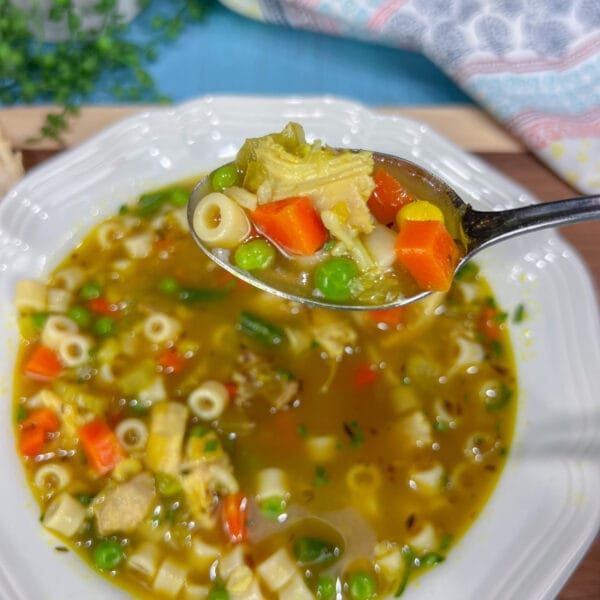
Five Reasons to Cook Noodles Separately
You and I are always looking for shortcuts – so it makes sense just to add a little more liquid and cook the noodles along with the rest of the soup. After all, they’ll be more flavorful that way – right? That is true, but you trade flavor for the risk of mushy noodles. Here’s why I like to cook noodles separately and wash an extra pot!
1.Texture Control:
- Cooking noodles or rice separately allows for precise control over the texture of each component. When cooked directly in the soup, there’s a risk of noodles or rice becoming overly soft and mushy, compromising the overall eating experience. Separately cooked noodles or rice retain their individual integrity, ensuring a satisfying bite.
2.Batch Cooking Convenience:
- Cooking noodles or rice separately provides batch cooking convenience. When prepared separately, noodles or rice can be stored independent of the soup, allowing for larger quantities to be made without compromising storage quality. This is particularly beneficial for those who enjoy preparing meals in advance or for larger gatherings.
3.More Choices:
- Cook your carbs separately and you have more choices for how to serve your soup. Choose traditional noodles, quinoa, rice, couscous, barley, wild rice or whole grains. This way you can eat your soup in many different ways.
4. Improved Freezeability:
- Noodles do not freeze well, they become soft and weak, often falling apart – it’s not a good look for a soup! So, if you want to freeze leftovers, it’s best if the noodles or other carbs are kept separately.
5. Broth Quality
- When noodles or other carbs are cooked in the soup, they release starch which can lead to cloudiness. And, those starches soak up a lot of liquid – so you’ll either have to add more broth or water when cooking the soup (potentially watering down the flavor) or your broth to filling ratio will be way out of whack and what’s soup with out the slurpy flavorful broth?!

Storing & Freezing Chicken Noodle Soup
To Store Chicken Soup:
- Cool the soup on counter (no longer than 1 hour).
- Choose an airtight container.
- Store in fridge for 3-4 days
To Freeze Chicken Soup:
Remember, it’s best to freeze without noodles, rice or potatoes as these won’t hold their texture very well.
- Cool soup completely.
- Store in airtight, freezer containers with room for expansion in convenient portion sizes.
- Label well.
- Store for 3-6 months, it will be safe to eat long after that, but for best quality use within that time.
- Thaw in the fridge for 12-24 hours depending on size of container.
To Reheat Chicken Soup:
- Thaw in the fridge or 12- 24 hours depending on size of container.
- Reheat on medium heat in microwave, on stove, in crockpot or instant pot. Use gentle heat to avoid boiling or overcooking.
Avoid Mushy Noodles in Chicken Noodle Soup
See all those wide egg noodles in this soup? They’re delicious, but they can turn soft and mushy very quickly because they continue to absorb liquid long after the cooking is done.
The longer they stay in soup, the more liquid they absorb and the softer and mushier they get. Here are some tips to avoid mushy noodles:
- Add your noodles towards the end, after your hearty vegetables. Carrots, celery and onions will take much longer to cook than noodles.
- Slightly under cook the noodles. Check the package of the noodles your using and cook them a minute or two less than what the package recommends. Even when you take the soup off the stove, the residual heat in the pot will continue to cook the noodles.
- Only make as much soup as you’ll eat in one day. Noodles in soup might last until the day after, but not much longer than that.
- Cook noodles separately and add to each bowl as your serving the soup. This means another pot to wash and your noodles won’t be quite as flavorful as when they’re being cooked in broth – but they won’t get mushy!
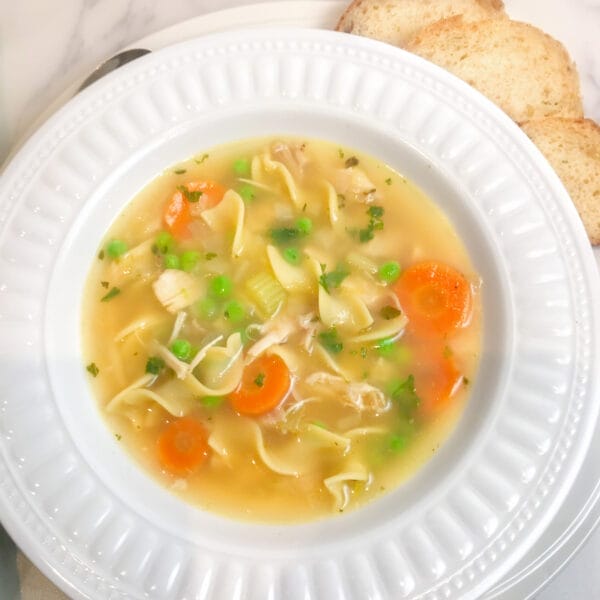
Recipe for Classic Chicken Noodle Soup
Classic Chicken Noodle Soup
Ingredients
- 2 cups uncooked pasta/rice or other grains (8 oz dry)
- 1 Tbsp oil
- 1 onion finely diced
- 2 celery ribs finely diced
- 2 carrots diced
- 3-4 cloves garlic minced
- 1-2 tsp ginger* freshly grated
- 1/2 tsp dried turmeric* 1 Tbsp fresh
- ½ tsp dried thyme** 3 sprigs fresh
- 1/2 tsp dried oregano
- 8 cups chicken stock
- 1 bay leaf
- 2 cups cooked chicken pieces
- 1 cup frozen peas or other cooked or frozen veggies
- Salt and pepper to taste
- ½ to 1 Tbsp lemon juice to taste
- 2 Tbsp chopped fresh parsley
Instructions
- In large pot, cook choice of pasta, rice or other grains according to package directions. Set aside when done.
- In separate large, heavy pot, heat oil over medium high heat.
- Add onion, celery, and carrots. Cook until onions are translucent, 3 to 5 minutes.
- Stir in garlic, ginger, turmeric and thyme and cook until fragrant, about 30 seconds.
- Add stock and bay leaf and bring to boil. Reduce heat, cover with lid partially askew and simmer until vegetables are nearly tender, 6 to 8 minutes.
- Add cooked chicken and frozen peas (or other vegetables) and heat through, 5 minutes.
- Taste and adjust seasoning, including lemon juice.
- Remove from heat and add fresh parsley.
- Place warm noodles or other grain in bowl and add soup on top.
Notes
Nutrition Facts (per serving)
More Recipes
Every great soup deserves a good side. We love Homemade No Knead Bread with our soup.
If you want another great chicken soup recipe check out my recipe for Chicken Corn Chowder. It is knock your socks off good! In fact, it was the winning soup in a soup cook-off a couple of years ago.
I’d love to hear your comment or see your results when you make this homemade chicken noodle soup. Please leave a comment or take a photo and tag #getgettys so I can see it and like it!
Sign up to get articles by Getty delivered to your inbox. You’ll get recipes, practical tips and great food information like this. Getty is a Professional Home Economist, speaker and writer putting good food on tables and agendas. She is the author of Manitoba’s best-selling Prairie Fruit Cookbook, Founder of Fruit Share, a mom and veggie gardener.



